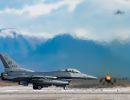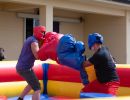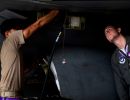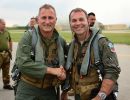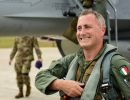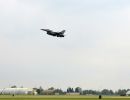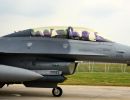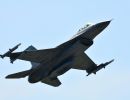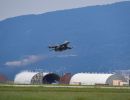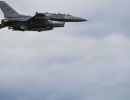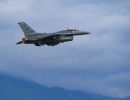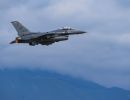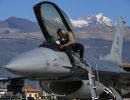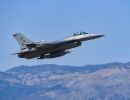I. GENERAL DESCRIPTION OF THE MISSION
II. COMPOSITION OF THE FORCE
III. NARRATIVE SUMMARY OF OPERATION
IV. RESUME OF OPERATION
V. ANALYSIS OF THE COMPLETE OPERATION
TAB A. OPERATIONS
TAB B. INTELLIGENCE
TAB C. LOGISTICS
TAB D. COMMUNICATIONS
TAB E. PERSONNEL
TAB F. COMMAND RELATIONS
TAB G. ADMINISTRATION
TAB H. MEDICAL
TAB I. COMPTROLLER
TAB J. OTHER
TAB K. RECOMMENDATIONS
THIS PAGE BY ITSELF IS UNCLASSIFIED
I. GENERAL DESCRIPTION OF THE MISSION:
The 510th Tactical Fighter Squadron deployed six aircraft to Takhli, Thailand as a show of force and as a force to be employed under the operational control of the 2nd Air Division in support of PACAF Plan 37, Plan 32 and Plan 99.
II. COMPOSITION OF THE FORCE:
6 F-100 Aircraft
8 Officers
34 Airmen
III. NARRATIVE SUMMARY OF OPERATIONS:
Major Abersold arrived at Takhli 5 June 1964. He arrived early to completely familiarize himself with the Det 1, 3rd TFW Operation before the arrival of the main body, anticipated 7 June 1964.
On 6 and 7 June 1964 Det 1 flew 10 sorties in support of a rescue mission in Laos. Only one flight of three expended ordnance in support of the mission. At Rescue Control’s direction the flight attacked gun emplacements on 7 June 1964 and inflicted unknown damage on several emplacements using 20mm cannon, the only armament aboard.
The Cross Switch package arrived 8 June 1964; received individual job briefings during the first hour after landing and immediately assumed a 15-minuter alert posture. Cross Switch the First departed about 3 hours after their relief landed.
Det 1 remained on 15-minute alert through 9 June 1964. A normal training program was resumed 10 June 1964. The remainder of the week was spent conducting local area checkouts (navigation and instruments) for the new arrivals.
From 8 June 1964 through 22 August 1964 many hours of ground school were conducting covering: Targeting, CBU, AGM-128 and GAR-8 with emphasis on delivery techniques and tactics. Also covered was LAU-3 rocket launchers, techniques for firing 2.75 rockets, 20mm cannon against gun emplacements and general tactics to be utilized for small arms and flak suppression.
All 3rd Tactical Fighter Wing Pilots, except Major Abersold departed 13 June 1964 for Da Nang, South Vietnam, via Clark AB, PI to practice simulated AGM-12 runs. The 615th Tactical Fighter Squadron pilots replaced them. Det 1 pilots were sent to Da Nang because they were the only AGM-12 qualified pilots available and that weapon was being considered for armed escort of F-101 photo recee sorties over Laos.
Sattahip Range, a rock in the Gulf of Siam, was utilized from 15 through 19 June 1964. All sorties were flown without external fuel tanks. Low level navigation, within local regulations, was used to the range. A special weapon delivery, LADD or TPU, was made straight into the target, followed by other deliveries as briefed. Minute planning, thorough briefing and careful navigation was necessary to deliver the ordnance accurately and expeditiously in order to depart the range at bingo fuel. The results were gratifying.
Period from 22 June through 10 July 1964. No range was available. Stress was placed on ACT. Flights of 2 practiced individual tactics. Flights of 4 split into elements for ACT practice with 2 on 2. Combat formation with a high element was practiced. GAR-8 attacks were made with the aid of GCI, directing 90 degree stern intercepts.
By 10 July 1964 all 3rd Tactical Fighter pilots were back at Takhli. They had been flying armed escort for F-101 aircraft conducting photo recce over Laos. The pilots had been attached to the 615th ADVON at Da Nang, South Vietnam. No AGM-12 ordnance was ever utilized.
The period 13 July through 17 July 1964 involved conventional and some special weapons training at Chibaden Air-Ground Range. Only skip bomb and strafe could be ground scored. Bombing, using a 30 degree dive angle was attempted for the first time with excellent results. Different rocket dive angles were tried to better familiarize the pilots with the tactical situation that might be encountered locally.
Period 20 through 30 July 1964. Again emphasis shifted to ACT for the 3rd Tactical Fighter Wing pilot’s benefit. Several navigation and instrument missions were also conducted during this period.
Through the efforts of 2 of the 510th Tactical Fighter Squadron pilots TDY at Clark, all the necessary dart equipment was borrowed from Clark, the dart range was secured for the first time by 35th tactical Group and air-to-air dart firing commenced 4 August 1964. Two pilots fired on the dart. The second dart for the day was lost as it was launched. On 5 August 1964 dart practice was resumed with 3 pilots firing at one dart.
At 0410Z 5 August 1964 Det 1 was placed on DEFCON 3 and directed to assume 1 hour alert posture; no flying except as directed.
From 6 August 1964 through 13 August 1964 there were F-100’s arriving from and departing for Clark daily. Three 615th TFS ADVON pilots and aircraft arrived and departed. The 522nd TFS ADVON arrived.
On the morning of 14 August 1964 4 aircraft were to meet a KC-135 over Korat, refuel and fly local. Another 4 were to rendezvous, refuel and proceed to Clark. At 0315 local time the Detachment was again placed on 15-minute alert. Eight aircraft were loaded with 2 LAU-3 rocket launchers and 800 rounds 20mm, three with 2 CBU and 3 with 2 AGM-12. The latter 6 aircraft were for another commitment and on one hour alert status.
On 14 August 1964 there were 12 sorties flown in support of rescue operation in Laos. All 12 aircraft expended ordnance at the direction of Victor Rescue Control, the “on Scene Commander”, to suppress ground fire. All but one LAU-3 launcher fired. Two aircraft had a single gun malfunction. A third flight of 4 was scrambled but directed to fly local as weather had deteriorated in the search area.
From 15 through 17 August 1964 all local flying was directed by 2nd Air Division Frag Orders.
At 0600Z 15 August 1964 the 2 airborne sorties received a recall. They were on the ground 10 minutes later. Another rescue mission was in progress. Two aircraft were scrambled at 0800Z, two more at 0900Z. All proceeded to the search area armed with 2 LAU-3 launchers and 20mm. They made several attempts, under GCI control, to intercept and identify unknown high speed aircraft approaching from the North. Their efforts were in vain due to their unwieldy external loads. Permission to clean the wings could not be secured. Each time an intercept was in progress the unidentified aircraft headed back to the North. The first 4 Rescap aircraft utilized air refueling 3 times to extend their time in the area. At sunset 2 aircraft were directed against gun emplacements, believed to be 37mm. Apparently the darkness greatly enhanced the gunners accuracy. The wingman, a 522nd TFW ADVON pilot received battle damage which caused a fuel leak and he headed South for the nearest friendly territory and began to rendezvous with a KB-50. He flamed out when about ½ mile in trail with the tanker, ejected safely just within Thailand and was picked up in short order by a rescue chopper from Udorn. The entire rescue operation was very precise and it was apparent that the pilot’s former jump training contributed to his effectiveness in this situation.
A second flight of 4 was scramble at 1820 local time and arrived at the scene just in time to CAP the bailout. They departed the area with GCI permission after the pilot was located and fuel dictated.
The rest of the TDY period was under direct control of 2nd Air Division, who continued to direct all local flying by Frag Order.
IV. RESUME OF OPERATION:
A. 6 through 30 June 1964.
1) 70 sorties flown, 10 of which were combat sorties.
2) 103 hours, 20 minutes flown.
B. 1 through 31 July 1964.
1) 93 sorties flown, 2 aborts.
2) 150 hours flown.
C. 1 through 25 August 1964.
1) 77 sorties, 20 of which were combat sorties.
2) 137 hours, 05 minutes flown.
V. ANALYSIS OF THE COMPLETE OPERATION:
TAB A – Operations
1. Range availability for continuation training: three ranges are available for gunnery training.
a. Satahip Range, a nuclear delivery range south of Bangkok, air scoring only.
b. An air-to-air range, south of Bangkok.
c. Chibaden Range, a small conventional range with facilities for ground control and ground scoring of skip bomb and strafe missions.
Generally facilities are adequate for fulfilling quarterly continuation training. Deficiencies: Strafe targets are 15’ by 15’, foul line is 1200’, the conventional range is available for a maximum of two missions a day – one week out of each month.
2. Runway lighting: Only the first 6000’ of runway 18 had operable lighting during this deployment period. This precluded night training operations. Action is being taken by the base to secure temporary portable lighting.
3. This TDY period was an unusual one from many viewpoints. During the period the primary mission changed from prestrike planning in support of Plan 31, 99 and 37 to fire suppression in support of rescue operations in Laos. During the TDY period the detachment flew thirty sorties in active support of rescue operations in Laos.
4. The number of aircraft involved in the operation at Takhli was increased from 6 F-100’s to 10 F-100’s and 4 KB-50’s in early August with a comparable build up in personnel. Active planning for specific targets was accomplished and 2nd Air Div started direct control by fragging all missions. Local training was directed toward refueling training, duplicating procedures and tracks to be used for actual employment.
5. On 25 August 1964 replacement personnel arrived by C-135 aircraft and after a two-day standdown for briefing, directed by 2nd Air Div, Sawbuck 11 personnel departed via the same aircraft.
TAB B – Intelligence
1. Intelligence Data: Initially there was a lack of current information in areas of Laos and Vietnam concerning location of concentrated ground fire and safe areas. At time of departure all information available was being distributed to the detachment, including daily courier delivery of up to date photos.
2. Target Materials: Planning folders containing all data required for preplanning strikes in any area were available. We had so many folders that safeguarding them became a problem and because safes were not available dome were stored in the communications crypto room temporarily.
TAB C – Logistics
1. During the month of June 1964 receipt of aircraft parts and supplies was extremely slow. Delays in transportations and communications outages contributed to the lack of support. Procedures established by the Commander, 405th Fighter Wing to assure receipt of all messages and expeditious handling within base supply resulted in outstanding support from mid July 1964 on.
2. WRM – No TDC program had been initiated to insure modification of pylons in base WRM. Type III pylons had not been modified for CBU’s and Type VIII pylons had not been modified as required after M1 wire modifications of aircraft. Action is being taken by 35th Tac Gp to accomplish necessary modifications.
TAB D – Communications
1. Initially communications between the Detachment and 35th TAC GP were unsatisfactory. It was not unusual for the MK-80 equipment to be out for 4 to 5 hours at a time several times a week.
2. When operational control was assumed by Det 2 35th TAC GP at UDORN back up circuits were installed and communications became adequate for the first time.
TAB E – Personnel
Authorization is adequate for a stable situation with 6 aircraft.
TAB F – Command Relationships
Satisfactory.
TAB G – Administration
Satisfactory.
TAB H – Medical
Satisfactory.
TAB I – Comptroller
Personnel were paid once a month only. This initially caused a hardship on several airmen who had obligations base on twice a month pay.
TAB J – Other
None.
TAB K – Recommendations
1. The two-day replacement delay for briefing of the incoming unit can be eliminated by sending an advanced party of key personnel approximately a week early.
2. Recommend a maintenance officer be authorized for the detachment. The fluctuation in numbers of aircraft and maintenance personnel, if continued, will make it extremely important that one man completely familiar with the operation be in charge of maintenance for the sake of continuity. This is too big a job to be handled by a pilot as an additional duty.
3. Recommend during periods of buildup, when the detachment is augmented with additional aircraft and personnel that intelligence personnel, one officer and one airman, be included.
/a/ Edward G. Abersold
EDWARD G. ABERSOLD
Major, USAF Detachment Commander
A TRUE COPY:
CONAN S. WILL, JR
Major, USAF Chief, Intelligence Division

























